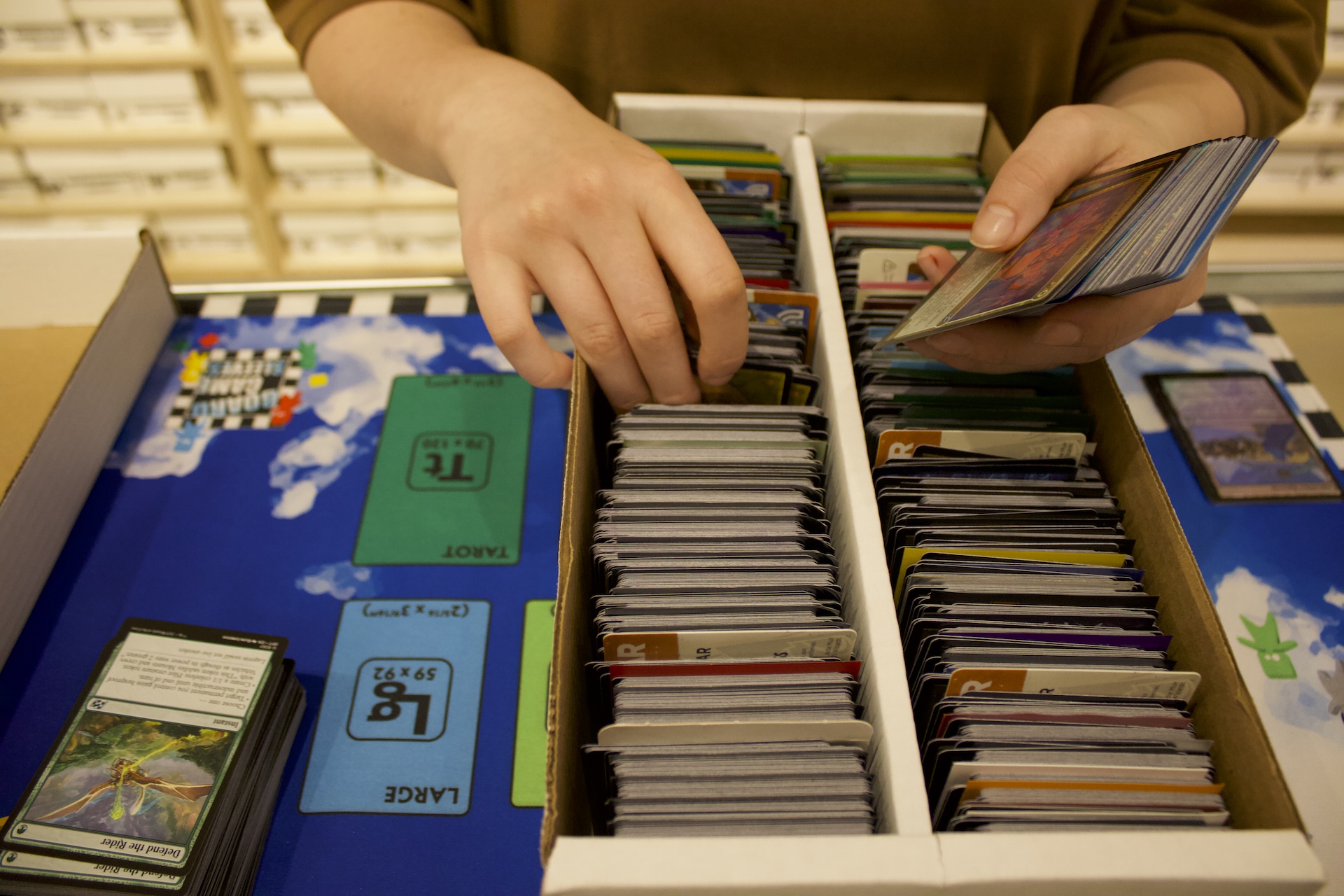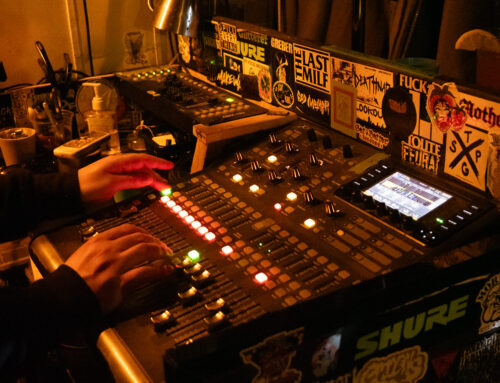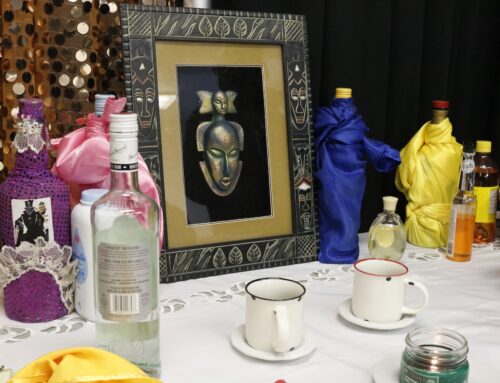BY Sarah-Maria Khoueiry & Zunayet Anis
Once or twice a week, Mikao Fortin goes to Boutique Expédition in Montreal’s La Petite Patrie neighbourhood to play Magic: the Gathering (MtG) with friends and other members of the community. Though he works at the store, he still chooses to spend time there as a customer because of the community it has fostered over the years.
“I have a huge number of friends I see on a daily basis who are in my life thanks to Magic [the Gathering],” Fortin says. “I keep playing because I want to see these people. If I didn’t have these friends I don’t think I’d be playing.”
MtG is a fantasy card game where players collect cards, creating their own decks to participate in tournaments and casual games with friends. Though traditionally played in pairs, the game-makers have introduced a format played in groups of four called Commander. The option to play in larger groups has steered the game away from a competitive hobby to a more relaxed and casual way of playing and collecting.
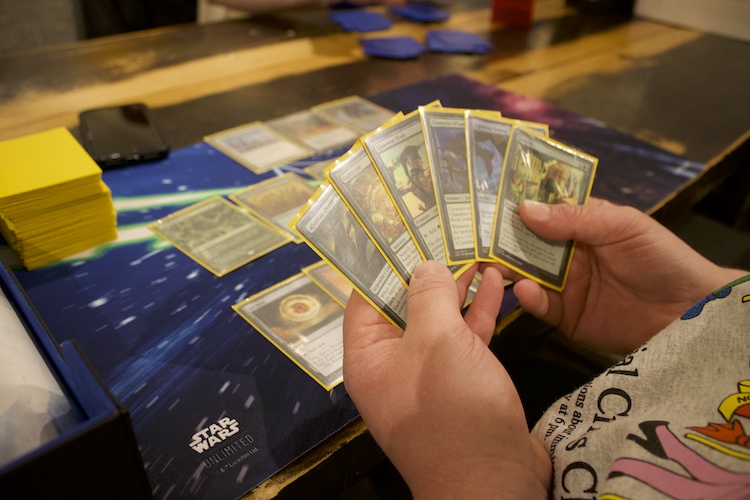
A hand of Magic: the Gathering Commander cards. Photo by Sarah-Maria Khoueiry.
Many in this community gained an interest after being introduced to these games by family members. Fortin inherited his passion for MtG from his father.
“I grew up with these games around me,” Fortin says. “What drew me in at first was the art, and then with time it became a game I was really familiar with.”
L’Expédition has been open for nine years and organizes daily events. Most of them are to play different versions of MtG.
A map of Montreal’s most prominent card game shops hosting activities for players. Infographic by Sarah-Maria Khoueiry.
Marc-Aurèle Lefebvre, an employee at Le Valet d’Cœur’s MtG section, attributes the game’s continuing success to its large fanbase.
“Other games, like Final Fantasy—they sound nice but no one plays them. There’s no community for these games in Montreal, whereas, for [MtG], you know you’re always going to find someone to play with,” he says.
People gather for an official Netrunner district championship hosted at Silver Goblin, 15 to 20 people are competing. Caleigh Mceachern prefers a smaller fanbase.
“[Netrunner], it’s a really tight-knit community,” Mceachern says. “Everyone knows everyone. With Magic, they’re also welcoming but there are a lot more people.”
Andrei Zanescu is a researcher who specializes in game studies. He has noticed players’ desire to socialize with store owners and other players.
“Tabletop gaming has been on the rise since 2015,” Zanescu says. “Generally, people are happy to go to these spaces. And [MtG], which is the big buttress for these stores, has only been increasing revenue in product sold, every single quarter, going back as far as 2014.”
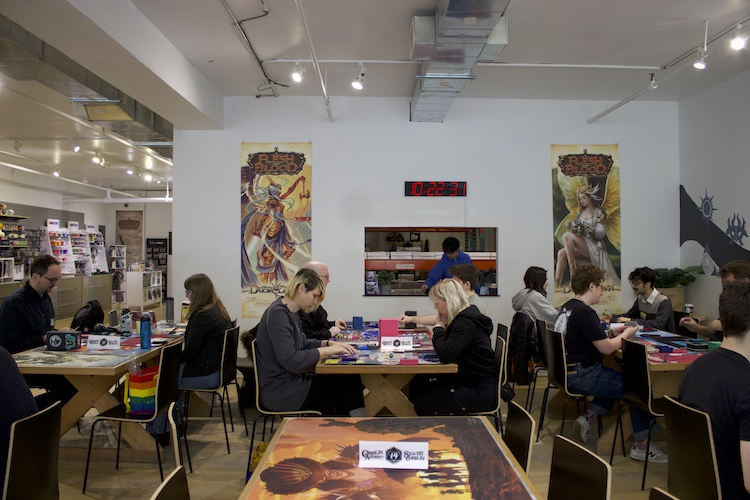
Competitors at Montreal’s Netrunner district championship hosted by Silver Gobelin. Photo by Sarah-Maria Khoueiry.
According to Lefebvre, the latest MtG trend is having developers collaborate with other franchises such as Doctor Who to open avenues to even more players. It is, however, alienating the game’s older fanbase.
“It’s a lot less interesting for me, and it disconnects me from the fantasy universe I knew,” Lefebvre says. “I’m not as informed about the new cards that are coming out as I was before; it’s more about the nostalgia of playing like I did 10 years ago. It’s really what has been driving Magic [the Gathering] forward these past months, even though, at the end of the day, it’s what kills me and a lot of long-time players.”
This dilemma of how to preserve nostalgia while developing the game is not exclusive to MtG.
Other card games, like Flesh and Blood or Sorcery, are betting on the nostalgia factor to sell. According to Léonard Blais-Hurtubise, co-owner of L’Expédition, games like these are aiming to be what MtG was at its beginning.
However, for Pokémon players, the game is not as interesting as it once was. The mechanics of it have become too simple for an older audience. The “pokemontrades” subreddit has 600,000 members and is in the top one per cent of the platform’s communities. The cards have thus taken on a new meaning, becoming a currency of their own.
What was once a fun game for children has become monetized by private collectors and rendered it inaccessible for fans unable to spend hundreds and thousands of dollars to acquire cards. Cards featuring Pikatchu, a fan-favourite character, sell for anywhere from four dollars to over $1,000 on eBay.
Private sales also happen between collectors, with rare cards going for hundreds of thousands of dollars.
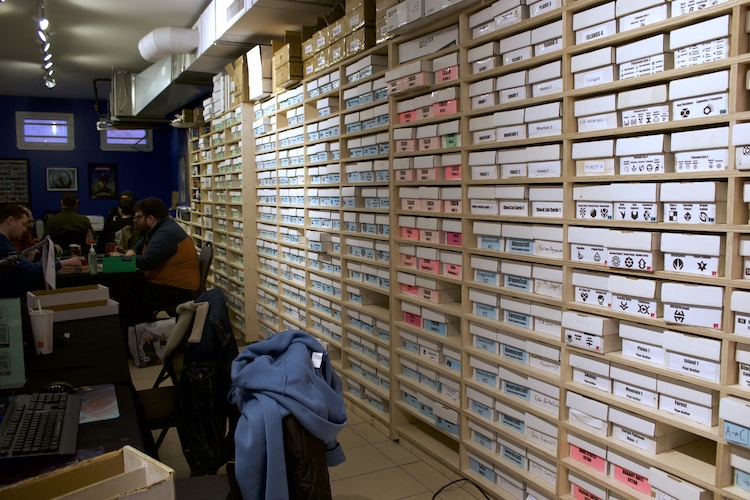
L’Expédition’s card stock fills the shop’s entire back wall. Photo by Sarah-Maria Khoueiry.
Blais-Hurtubise has noticed an uptick in MtG spin-offs and multi-fandom crossovers, but he believes the current trend driving the card-game industry is Pokémon card-collecting.
“It’s a game anchored in the nostalgia of the 20-to-40 year-olds’ generation who collect the cards because they’re characters from their childhoods and they now have the financial capital to do so,” Blais-Hurtubise says. “Nostalgia sells.”
Pokémon has always been popular, but starting at the end of 2024, Blais-Hurtubise noticed a significant increase in demand.
“People are fighting over them,” he says. “Parents are coming into the shop frantically looking for specific cards, and when they find we’re sold out, they run to the next shop. It’s a race.”
This practice has gone mainstream with famous social media influencers partaking in the trading. Some long-time players are getting priced out of the game due to this.
For example, the most expensive Pokémon card ever bought is attributed to Logan Paul, an American influencer and professional wrestler. He bought a 1998 Illustrator Pikachu card for a total of US$5.275 million in 2022. Paul counts 23.6 million subscribers on YouTube.
The fluctuation of card prices makes the practice of playing and/or collecting risky, as the price of certain cards oscillates unpredictably. For example, a Pokémon First Edition Shadowless Holographic Charizard #4 from 1999 was bought for US$420,000 in 2022, but sold for US$168,000 in 2024, losing 60 per cent of its value.
Dr. Xiao Huang, a professor at Concordia University’s JMSB believes the pricing of these cards does operate under supply and demand laws, but in the case of this industry, the manufacturer has considerably more control over the product than in others.
“It’s one of these very rare industries where the company will have a bit more say about both ends of the equation,” she says. “So that makes it a bit harder for customers to speculate about what might be going on in the future.”
As trading cards grow in popularity, so does the financial risk. The thrill of opening booster packs raises concerns about gambling-like behaviour. Video by Zunayet Anis.
Online versions of fantasy card games have become somewhat popular in the past few years, mainly because they offer a budget-and-beginner-friendly alternative to familiar favourites. However, technology-based variants of the games still miss the human interaction of traditional fantasy card games.
Ever since the pandemic, shops have seen increased demand for in-person events for players to come together. This preference shows that no matter how technology evolves, the desire to connect with people who share similar interests remains. Though the convenience of online gaming is apparent—both financially and time-wise—many still choose to come out and enjoy each other’s company. Of the 50 million players, according to Hasbro, MtG’s owner, only 13 million are registered to Magic Arena, the online platform for MtG players.
Zanescu thinks digital play-experiences appeal to both professional players, and the ease of use it provides to more casual players. However, some formats of games like MtG aren’t offered online. This “middle space,” as Zanescu calls it, will continue evolving as shops hone in on micro-cultures and retain loyal customers.
“The numbers seem to indicate that digital will keep growing,” Zanescu says. “It doesn’t mean that analog stores will die out, it probably means that some of them will, the ones that seem less player-based. But the ones that do curate a very positive experience that people will come back for, will thrive and shift into something more than just a place where you go to buy product, but a community space where you know the people running the store, you know the people who go there, and you’re part of that gang of people.”
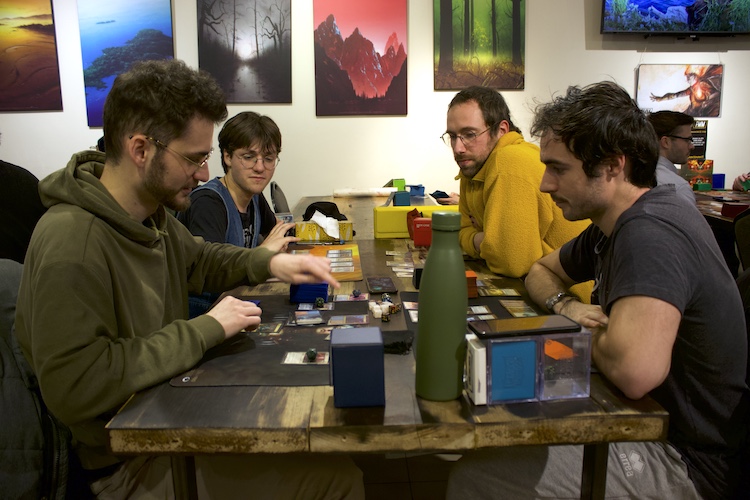
A group of friends playing together during L’Expédition’s casual MtG Commander night. Photo by Sarah-Maria Khoueiry.
Blais-Hurtubise noted the parallel rise in popularity of other “analog” activities, such as board games and arcades and flip-phones. He says it doesn’t make sense for these things to come back, but “people need to go out, with friends, with strangers.”
His shop currently gathers around 50 attendees per event.
“In our community, our players were asking us to host in-person events, even during the pandemic,” Blais-Hurtubise says. “We got Plexiglass dividers; we reworked our common space. We had a full house every time. People were booking two or three weeks in advance to attend. I don’t think we’ll ever lose it—the physical gameplay. Having discussions, laughs, arguments with real people—you can’t have that online.”
